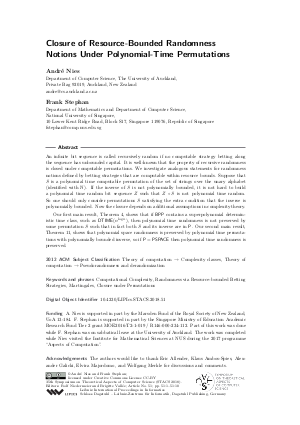Closure of Resource-Bounded Randomness Notions Under Polynomial-Time Permutations
Authors André Nies, Frank Stephan
-
Part of:
Volume:
35th Symposium on Theoretical Aspects of Computer Science (STACS 2018)
Part of: Series: Leibniz International Proceedings in Informatics (LIPIcs)
Part of: Conference: Symposium on Theoretical Aspects of Computer Science (STACS) - License:
 Creative Commons Attribution 3.0 Unported license
Creative Commons Attribution 3.0 Unported license
- Publication Date: 2018-02-27
File

PDF
LIPIcs.STACS.2018.51.pdf
- Filesize: 453 kB
- 10 pages
Document Identifiers
Subject Classification
Keywords
- Computational complexity
- Randomness via resource-bounded betting strategies
- Martingales
- Closure under permutations
Metrics
- Access Statistics
-
Total Accesses (updated on a weekly basis)
0Document
0Metadata
Abstract
An infinite bit sequence is called recursively random if no computable strategy betting along the sequence has unbounded capital. It is well-known that the property of recursive randomness is closed under computable permutations. We investigate analogous statements for randomness notions defined by betting strategies that are computable within resource bounds. Suppose that S is a polynomial time computable permutation of the set of strings over the unary alphabet (identified with the set of natural numbers). If the inverse of S is not polynomially bounded, it is not hard to build a polynomial time random bit sequence Z such that Z o S is not polynomial time random. So one should only consider permutations S satisfying the extra condition that the inverse is polynomially bounded. Now the closure depends on additional assumptions in complexity theory. Our first main result, Theorem 4, shows that if BPP contains a superpolynomial deterministic time class, then polynomial time randomness is not preserved by some permutation S such that in fact both S and its inverse are in P. Our second result, Theorem 11, shows that polynomial space randomness is preserved by polynomial time permutations with polynomially bounded inverse, so if P = PSPACE then polynomial time randomness is preserved.
Cite As Get BibTex
André Nies and Frank Stephan. Closure of Resource-Bounded Randomness Notions Under Polynomial-Time Permutations. In 35th Symposium on Theoretical Aspects of Computer Science (STACS 2018). Leibniz International Proceedings in Informatics (LIPIcs), Volume 96, pp. 51:1-51:10, Schloss Dagstuhl – Leibniz-Zentrum für Informatik (2018)
https://doi.org/10.4230/LIPIcs.STACS.2018.51
BibTex
@InProceedings{nies_et_al:LIPIcs.STACS.2018.51,
author = {Nies, Andr\'{e} and Stephan, Frank},
title = {{Closure of Resource-Bounded Randomness Notions Under Polynomial-Time Permutations}},
booktitle = {35th Symposium on Theoretical Aspects of Computer Science (STACS 2018)},
pages = {51:1--51:10},
series = {Leibniz International Proceedings in Informatics (LIPIcs)},
ISBN = {978-3-95977-062-0},
ISSN = {1868-8969},
year = {2018},
volume = {96},
editor = {Niedermeier, Rolf and Vall\'{e}e, Brigitte},
publisher = {Schloss Dagstuhl -- Leibniz-Zentrum f{\"u}r Informatik},
address = {Dagstuhl, Germany},
URL = {https://drops.dagstuhl.de/entities/document/10.4230/LIPIcs.STACS.2018.51},
URN = {urn:nbn:de:0030-drops-84938},
doi = {10.4230/LIPIcs.STACS.2018.51},
annote = {Keywords: Computational complexity, Randomness via resource-bounded betting strategies, Martingales, Closure under permutations}
}
Author Details
References
-
K. Ambos-Spies and E. Mayordomo. Resource-bounded measure and randomness. Lecture Notes in Pure and Applied Mathematics, pages 1-48, 1997.

-
V. Brattka, J. Miller, and A. Nies. Randomness and differentiability. Transactions of the AMS, 368:581-605, 2016. arXiv version at arxiv.org/abs/1104.4465.

-
H. Buhrman, D. Van Melkebeek, K. Regan, D. Sivakumar, and M. Strauss. A generalization of resource-bounded measure, with application to the BPP vs. EXP problem. SIAM Journal on Computing, 30(2):576-601, 2000.

-
R. Downey and D. Hirschfeldt. Algorithmic randomness and complexity. Springer-Verlag, Berlin, 2010. 855 pages.

-
S. Figueira and A. Nies. Feasible analysis, randomness, and base invariance. Theory of Computing Systems, 56(3):439-464, 2015.

-
D. Hirschfeldt, A. Nies, and F. Stephan. Using random sets as oracles. J. Lond. Math. Soc. (2), 75(3):610-622, 2007.

-
B. Kjos-Hanssen, P. Nguyen, and J. Rute. Algorithmic randomness for doob’s martingale convergence theorem in continuous time. arXiv preprint arXiv:1411.0186, 2014.

-
M. Li and P. Vitányi. An introduction to Kolmogorov complexity and its applications. Graduate Texts in Computer Science. Springer-Verlag, New York, second edition, 1997.

-
P. Martin-Löf. The definition of random sequences. Inform. and Control, 9:602-619, 1966.

-
A. Nies. Lowness properties and randomness. Advances in Mathematics, 197:274-305, 2005.

- A. Nies. Computability and Randomness, volume 51 of Oxford Logic Guides. Oxford University Press, Oxford, 2009. 444 pages. Paperback version 2011. URL: http://dx.doi.org/10.1093/acprof:oso/9780199230761.001.0001.
- André Nies. Differentiability of polynomial time computable functions. In Ernst W. Mayr and Natacha Portier, editors, 31st International Symposium on Theoretical Aspects of Computer Science (STACS 2014), STACS 2014, March 5-8, 2014, Lyon, France, volume 25 of LIPIcs, pages 602-613. Schloss Dagstuhl - Leibniz-Zentrum fuer Informatik, 2014. URL: http://dx.doi.org/10.4230/LIPIcs.STACS.2014.602.
-
C.P. Schnorr. Zufälligkeit und Wahrscheinlichkeit. Eine algorithmische Begründung der Wahrscheinlichkeitstheorie. Springer-Verlag, Berlin, 1971. Lecture Notes in Mathematics, Vol. 218.

-
Michiel van Lambalgen. The axiomatization of randomness. J. Symbolic Logic, 55(3):1143-1167, 1990.

-
Y. Wang. Randomness and Complexity. PhD dissertation, University of Heidelberg, 1996.

